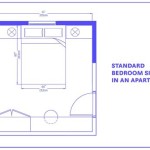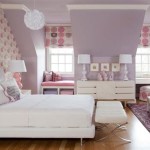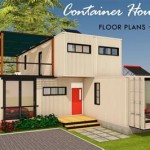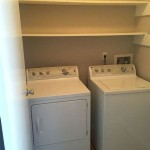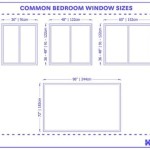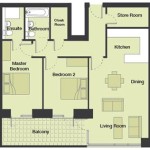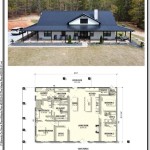Two Bedroom Cottage Floor Plans: Designing Cozy and Efficient Living Spaces
Two-bedroom cottage floor plans represent a popular housing choice, particularly for small families, couples, or individuals seeking a manageable and comfortable living space. These plans, often characterized by their efficient use of space and charming aesthetic, prioritize functionality and create a welcoming atmosphere. The appeal stems from the balance offered between affordability, ease of maintenance, and the potential for a personalized home environment. Examining the various aspects of two-bedroom cottage floor plans allows for informed decision-making when designing or selecting a suitable home.
Key Considerations in Two-Bedroom Cottage Design
Designing or selecting a two-bedroom cottage floor plan requires careful consideration of several key factors. These factors directly impact the livability, functionality, and overall satisfaction with the home. Understanding these aspects is essential for creating a space that meets individual needs and preferences.
Firstly, space optimization is paramount. Cottage designs, by definition, often involve limited square footage. Every room must be thoughtfully planned to maximize usability without feeling cramped. This often entails employing open floor plans that combine living, dining, and kitchen areas. Strategic placement of windows and doors also plays a crucial role in enhancing the feeling of spaciousness, allowing natural light to penetrate the interior and create visual connections with the outdoors.
Secondly, storage solutions are critical. With limited living space, efficient and creative storage solutions are essential. This may involve incorporating built-in shelving, under-stair storage, or utilizing vertical space with tall cabinets. Multi-functional furniture, such as sofa beds or storage ottomans, can also contribute to maximizing space and minimizing clutter. Careful planning of closet space in bedrooms and strategically placed storage areas throughout the cottage is vital.
Thirdly, accessibility should be a primary concern, particularly for individuals with mobility limitations or those planning to age in place. Ensuring that doorways are wide enough for wheelchair access, incorporating grab bars in bathrooms, and minimizing stairs within the floor plan are important considerations. Universal design principles should be integrated into the design to create a home that is accessible and comfortable for individuals of all abilities.
Finally, the overall aesthetic should align with personal preferences and the surrounding environment. Cottage designs often evoke a sense of warmth and charm, characterized by features such as exposed beams, natural materials, and cozy fireplaces. However, the specific style can be tailored to individual tastes, ranging from traditional and rustic to modern and minimalist. The exterior design should also complement the surrounding landscape and architectural context.
Common Two-Bedroom Cottage Floor Plan Layouts
Various layout options exist for two-bedroom cottage floor plans, each offering distinct advantages and catering to specific needs. Understanding these common layouts can serve as a starting point for selecting or customizing a design.
One common layout features bedrooms situated on opposite sides of the living area. This arrangement provides enhanced privacy for occupants, making it suitable for shared living situations or for creating a distinct separation between sleeping and living spaces. The living area serves as a central hub, connecting the bedrooms and providing a common space for relaxation and entertainment. This layout often includes a centrally located kitchen and dining area, fostering a sense of togetherness.
Another popular layout involves placing both bedrooms together on one side of the cottage. This configuration can be advantageous for families with young children, allowing parents to easily monitor and access their children's rooms. It also creates a distinct separation between the bedroom wing and the main living area, which can be beneficial for maintaining a quiet and peaceful sleeping environment. This layout may feature a larger combined living, dining, and kitchen area, maximizing the sense of openness and sociability.
A third layout option positions one bedroom on the main floor and the second bedroom on a separate level, often in a loft or attic space. This arrangement can be ideal for couples seeking privacy or for accommodating guests. The loft bedroom may offer unique architectural features, such as sloped ceilings or exposed beams, adding character to the cottage. This layout typically includes a compact main floor living area, emphasizing efficiency and maximizing the use of vertical space.
Irrespective of the chosen layout, the orientation of the cottage on the property is a critical consideration. Maximizing natural light and views, while also considering privacy and protection from the elements, will greatly enhance the livability and enjoyment of the home. Careful placement of windows and doors, as well as the strategic use of landscaping, can contribute to creating a comfortable and inviting living environment.
Optimizing Space in Small Two-Bedroom Cottages
Given the inherent space constraints of many two-bedroom cottages, optimizing the available square footage is essential. Several strategies can be employed to create a sense of spaciousness and functionality within a limited footprint.
Open floor plans are a cornerstone of space optimization in small cottages. By eliminating walls between the living, dining, and kitchen areas, a sense of continuity and flow is created. This allows natural light to permeate the entire space, making it feel larger and more inviting. Strategic use of furniture placement and area rugs can define distinct zones within the open plan, without sacrificing the overall feeling of spaciousness.
Vertical space utilization is another key strategy. Tall cabinets, shelving units, and lofted spaces can significantly increase storage capacity without consuming valuable floor space. Utilizing the height of walls and ceilings can create visually appealing and functional storage solutions. Consider incorporating built-in storage niches or using decorative shelving to display personal items and add character to the cottage.
Multi-functional furniture is an invaluable asset in small cottages. Sofa beds, storage ottomans, and dining tables that can be expanded or folded away are all examples of furniture pieces that serve multiple purposes. These pieces can be easily adapted to different needs, maximizing flexibility and minimizing clutter. Selecting furniture with a smaller footprint and a streamlined design can also contribute to creating a more spacious feel.
Natural light plays a crucial role in enhancing the perception of space. Maximize natural light penetration by incorporating large windows, skylights, and light-colored walls and finishes. Strategically placed mirrors can also amplify natural light and create the illusion of greater depth. Avoid using heavy curtains or drapes that block natural light, opting instead for lightweight sheer fabrics or blinds that allow light to filter through.
Finally, decluttering is essential for maintaining a sense of spaciousness in a small cottage. Regularly decluttering and organizing belongings will prevent the space from feeling cramped and overwhelming. Consider implementing a minimalist approach to decorating, focusing on essential items and avoiding excessive ornamentation. A well-organized and clutter-free space will feel more inviting and functional.
Adapting Two-Bedroom Cottage Plans for Specific Needs
While standard two-bedroom cottage floor plans provide a foundation, adapting these plans to meet specific needs and preferences is crucial for creating a truly personalized home.
For individuals who work from home, designating a dedicated workspace within the cottage is essential. This could involve converting a small corner of a bedroom into a home office, utilizing a spare closet as a workstation, or incorporating a built-in desk into the living area. Ensuring adequate lighting, comfortable seating, and sufficient storage for office supplies are vital for creating a productive and comfortable work environment.
For those who enjoy outdoor living, integrating outdoor spaces into the cottage design is highly desirable. This could involve adding a deck, patio, or porch that extends the living area outdoors. Creating a seamless transition between the indoor and outdoor spaces can enhance the feeling of spaciousness and provide opportunities for relaxation and entertainment. Consider incorporating outdoor furniture, landscaping, and lighting to create a comfortable and inviting outdoor living area.
For individuals with mobility limitations, adapting the cottage design to accommodate their needs is paramount. This may involve widening doorways, installing grab bars in bathrooms, minimizing stairs, and creating accessible pathways throughout the home. Universal design principles should be incorporated into every aspect of the design to ensure that the cottage is safe and comfortable for individuals of all abilities. Consulting with an architect or contractor specializing in accessibility can be beneficial for creating a truly accessible home.
For those seeking to maximize energy efficiency, incorporating sustainable design features into the cottage is a worthwhile investment. This could involve using energy-efficient windows and insulation, installing solar panels, and utilizing sustainable building materials. Designing the cottage to take advantage of natural light and ventilation can also reduce energy consumption. A well-designed and energy-efficient cottage will not only reduce utility bills but also minimize its environmental impact.
Finally, personalizing the aesthetic of the cottage to reflect individual tastes is essential. This could involve selecting specific color palettes, incorporating unique architectural details, and choosing furniture and decor that reflect personal style. Creating a home that is both functional and aesthetically pleasing will enhance the enjoyment and satisfaction of living in the cottage.

10 Gorgeous Ranch House Plans Ideas Bungalow Floor Modular Home Condo

2 Bedroom Cottage House Plan 21255dr Architectural Designs Plans

Country Style House Plan 2 Beds 1 Baths 1007 Sq Ft 44 158 Small Floor Plans Tiny

Unique Small 2 Bedroom House Plans Cabin Cottage

Country Porches 2 Bedroom Cottage Style House Plan 5712

Cottage Style House Plan 2 Beds 1 Baths 856 Sq Ft 14 239 In 2024 Cabin Floor Plans Bedroom

37 2 Bed Cottage Designs Ideas House Floor Plans Small
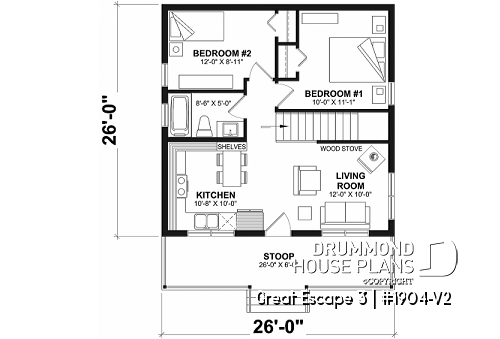
Unique Small 2 Bedroom House Plans Cabin Cottage

2 Bedroom Cottage House Plan 1200 Sq Ft Cabin Style

Simple Two Bedroom Cottage 80363pm Architectural Designs House Plans

